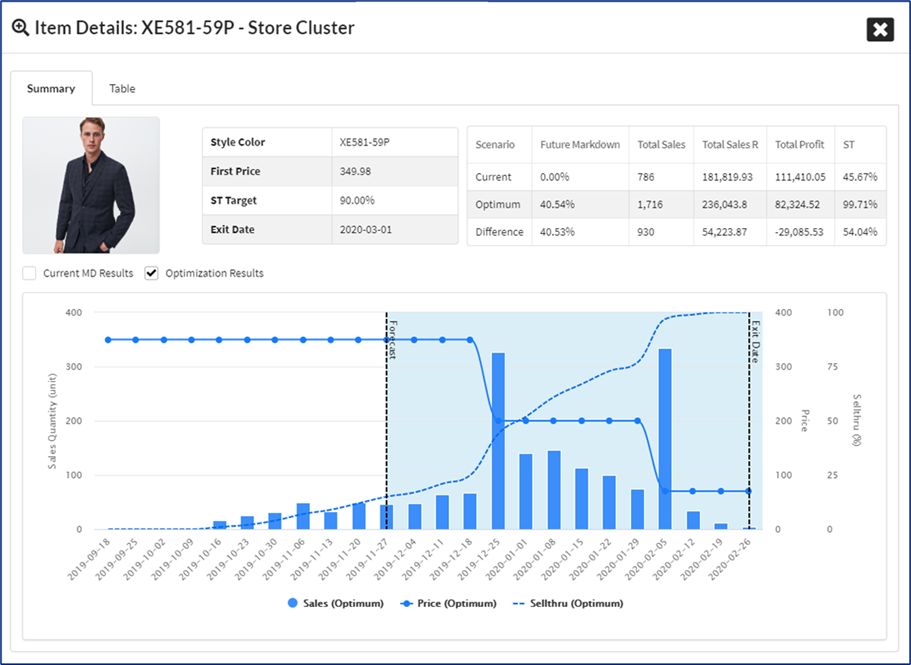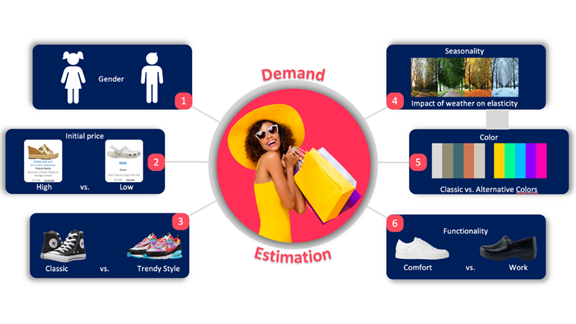
Markdown Optimization for Retailers: How AI Can Make Millions
It's no secret that retailers are always looking for ways to improve their margins. One way to do this is through markdown optimization. This involves making decisions about what items to mark down, and when to do it. Several factors go into determining when and how much to mark something down.
Retailers have traditionally made these decisions manually, but this can be time-consuming and often leads to poor results. In this blog post, we will discuss how AI can help retailers make better decisions, faster, and improve their bottom line!
What Is Markdown Optimization?
Markdown optimization is the process of making decisions about what products to sell at a discount, and when to do so. This can be a complex process, as there are several factors that go into determining the optimal time and depth to mark something down.
Some of these factors include:
- The current and future demand for the product
- The current inventory level of the product
- Sell Through and inventory to clear by the end of the season
- The season and seasonality of the product (Season, NOS, Potential Convert)
- Special Days in the future (Christmas, Valentine’s Day, and so on)
- The salvage value of the product for potential leftover inventory
- Life cycle of the product and desired exit date
- Attributes of the product
- Existing markdown ratios in competing products
- Price Elasticity of the product (The Most Critical Factor!)
In the past, retailers have made markdown decisions manually by only being able to consider a few of those factors. However, this can be time-consuming and often leads to poor results. This is where AI comes in. AI can help retailers make better decisions, faster, and improve their bottom line.
Why Does It Matter for Retailers?
According to a recent estimate, retailers globally lose $300 billion every year due to inefficient markdown processes. That's why it's so important for retailers to have a good markdown optimization strategy in place.
There are two main types of markdowns: planned and unplanned.
Planned markdowns are those that are done in advance, usually in response to seasonal changes or special promotions. Unplanned markdowns are those that are done on the fly, in response to changes in customer demand or other unforeseen circumstances. Both types of markdowns can be a major headache for retailers if they're not properly managed.
The goal of markdown optimization is to minimize the impact of markdowns on profits. To do this, retailers need to have a good understanding of how customers react to price changes and how to adjust prices accordingly. They also need to have a well-defined markdown strategy that takes into account both planned and unplanned markdowns.
By taking these steps, retailers can make sure that their markdown strategies are working as efficiently as possible and that they're not leaving money on the table.
Common Issues in Retail Markdown
Markdowns can be a major source of lost profits if not managed properly. There are a few common issues that arise concerning markdowns:
- Many stores wait too long to mark down items. This results in lost sales and profitability, as customers are often more reluctant to buy items that have been sitting on the shelves for a while. Instead, stores should aim to mark items down as soon as they are no longer selling at full price.
- Some planners mark items down too deeply. This may move merchandise more quickly, but it also erodes margins and reduces profits. Retailers should strike a balance between remaining competitive and generating a decent profit on each sale.
Finally, some retailers fail to track their markdown activity properly. This makes it difficult to measure the effectiveness of markdown strategies and optimize them over time. Tracking data helps retailers make informed decisions about their markdown strategy, such as:
- How often items are marked down
- How deeply they are discounted
- How quickly do they sell
How Can AI Help Retailers With Markdown Optimization?
In the retail industry, markdown optimization is a key method for maximizing profits and minimizing losses. In the past, retailers have relied on manual spreadsheet-based methods to determine when and by how much to mark down items by only considering the “Week Cover” KPI.
However, this approach is often inaccurate. Additionally, it doesn't take into account important factors such as future customer demand or price elasticity.
As a result, many retailers are turning to artificial intelligence (AI) to help with markdown optimization. AI-powered systems can analyze large amounts of data quickly and accurately.
They can also consider a variety of factors when making recommendations, giving retailers a more complete picture of the market. As AI continues to evolve, it will become an increasingly valuable tool for retail markdown optimization.

Key Benefits of an AI-Based Markdown Optimization Solution for Retailers
As a retailer, it's essential to maximize margins and optimize markdown strategies to stay ahead of the competition. An AI-based markdown optimization solution can help you do just that.
By using product attributes and estimating price elasticity, you can make more informed decisions about when to mark down items and by how much.
You can also evaluate various promotional strategies with optimally timed markdowns that differentiate between:
- Regions
- Climates
- Stores
Retailers can set different prices for each based on the location-level price elasticity.
Best of all, an AI-based tool can offer you visibility into sales and inventory levels throughout the season, so you can make adjustments as needed. With all of these benefits, it's no wonder that retailers who use an AI-driven markdown optimization tool are seeing a higher return on investment.
Maximize Margins
In the retail industry, margins are everything. It's essential to sell items at the right price to maximize profits while remaining competitive.
But pricing is a complex issue, and it can be difficult to know when to mark down items and by how much. That's where AI-based markdown optimization comes in.
By using data and artificial intelligence, these tools can help retailers make the best possible pricing decisions, leading to increased margins and overall profitability.
In addition, AI-based markdown optimization can help to improve customer satisfaction by ensuring that shoppers always have access to the best deals. As the retail landscape becomes increasingly competitive, tools like these will become essential for success.
Lowers Markdown Loss
There are many key benefits to using an AI tool for retailers. Perhaps most importantly, such a tool can help to lower markdown loss and increase sell-through for every item.
In other words, it can help retailers to make the most of their inventory, while also reducing waste.
Additionally, an AI tool can provide real-time insights into pricing trends and consumer behavior. This allows retailers to make more informed decisions about pricing, product selection, and promotional strategies. Ultimately, an AI tool can help retailers to improve their bottom line and better compete in today's dynamic marketplace.
Increases Sell-Through
An AI-powered solution can help retailers increase sell-through by achieving maximum margin and reduce leftover inventory at the end of the season. In addition, the solution can either optimize category sell-through targets or, each and every option. It also considers multi-step sell-through targets for different periods of the season.
Estimates Price Elasticity
AI uses product attributes to estimate price elasticity uniquely for each product, which allows retailers to see how sensitive customers are to price changes. Armed with this information, retailers can make more informed decisions about when and how much to mark down their products. As a result, they can minimize losses while still achieving their desired sales goals.
Machine Learning Models estimate the impact of product attributes on sales with machine learning-based product clustering

In today's competitive retail landscape, having access to this type of data can give retailers a major advantage.
Offers Visibility
One of the key benefits of an AI-based markdown optimization tool for retailers is the visibility it offers throughout the season. Through the use of data analytics, retailers can track sales and inventory levels in real time. It will allow you to:
- Act fast for seasonal products
- Avoid unnecessary early and deep markdowns
- Reduce your excess inventory
This is particularly useful during end-of-season sales. By having a clear picture of what is selling and at what price, retailers can ensure they are maximizing their profits.
In addition, AI-driven markdown tools can also help retailers to avoid overstocking by predicting consumer demand. This means that retailers can avoid the costly mistake of buying too much stock.
Coordinates With Various Promotional Strategies
To stay competitive, retailers need to be able to quickly and efficiently adapt to changes in the market. By constantly monitoring data points the tool can automatically suggest the ideal markdown price for each product.
This not only saves time and labor costs, but also allows retailers to coordinate with various promotional strategies and, what-if scenario evaluations.
In addition, the AI tool can also help evaluate different "what-if" scenarios. For example:
- What if a certain product is not selling well?
- What if there is a sudden surge in customer demand?
By constantly testing and evaluating different scenarios, retailers can easily see end-of-season projections and be better prepared for whatever changes might come their way.
Higher Return on Investment
AI-based markdown optimization tools can also help retailers to avoid the high cost of markdowns. By using these tools, retailers can sell more products at full price and avoid the need to deeply discount items to clear inventory. As a result, AI-based markdown optimization can help retailers to achieve a higher ROI on their inventory and improve their bottom line.
Choose Invent Analytics for Markdown Optimization
Invent Analytics accelerates your margin growth by optimizing markdowns throughout the product lifecycle.
With Invent Analytics, you can be confident that you are getting the best possible value for your products. Request a demo today to learn more about how we can help you optimize your markdown strategy.




